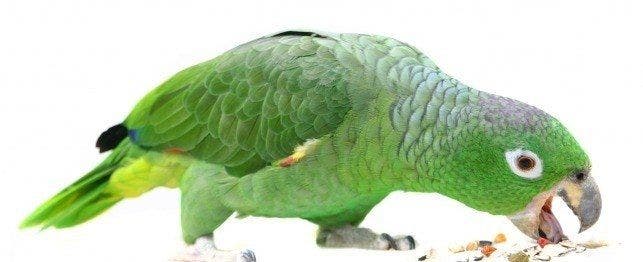
Choosing a Mealy Amazon
Mealy Amazons (Amazona farinosa) are intelligent, shy birds. They are also, unfortunately, aggressive and possessive. Males may become hostile to their owners during mating season and the birds have been known to bond with one person, loyally “protecting” them from everyone, including other family members.
Appearance and Personality
The birds – which are relatively rare in the United States – measure 15 to 16 inches, although males are generally larger than females and have larger heads and beaks. They are colorful creatures, bright green with prominent white eye rings. Some have patches of yellow and red on the crown and small patches of red on the carpus, or shoulder. Flight feathers have blue tips; tail feathers, red patches and yellow-green tips. When young, the birds’ eyes are brown; in maturity, they become orange-yellow.
The most coveted subspecies – the blue-crowned Amazon – has a violet-blue crown, which extends to the back of the head. Other subspecies include the farinose, found along Brazil’s Orinoco River; the inornata, native to Panama; chapmani, found mostly in Ecuador; and virenticeps, in Nicaragua and western Panama. These are less distinctive.
In the wild, the birds inhabit dense humid lowland plantations with tall trees, gallery forests, savannahs, and tropical deciduous forests. They probably survive 50 to 60 years or more in these conditions, although little is known about their life spans in captivity.
While mealy Amazons can be noisy – especially during mating season – they are not great speakers, compared to yellow-napes or yellow-heads. Mealy Amazons are active by nature and have a tendency toward obesity if closely confined, so they need space for exercise. The birds should also be provided with toys, blocks of wood or branches that they can chew. Young Amazons should be socialized to many people and exposed to a variety of situations such as new cages, toys, visits to the veterinarian, handling by friends, wing and nail clips, etc. to avoid fear of novel situations.
Acquired young, they make good family pets.
Grooming
Routine bathing or showering is vital to maintaining good plumage and skin condition. Birds can be misted and allowed to dry in a warm room or in the sun, or gently dried with a blow drier. Care should be taken not to clip the wing feathers excessively as Amazons often fall and injure themselves. Clip only the primary flight feathers and only enough so the bird can glide to the floor. Mealy Amazons are heavy bodied and care must be taken not to cut too many feathers. Excessive wing clipping can result in injuries from falling.
Feeding
Mealy Amazons should be fed a pelleted diet. Pelleted high protein diet is an excellent staple diet for Amazons, or a weaning food can also be fed. The diet should be supplemented with fresh fruits and vegetables daily to add variety.
Feed approximately 1/3 to 1/2 cup of pelleted food and 1/3 to 1/2 cup of fresh fruits and vegetables daily. Monitor food intake. Overfeeding leads to pickiness, selective feeding and wasteful throwing of food. Because of their tendency to obesity, mealy Amazons should be fed little or no sunflower or safflower seeds (seeds should only be given as treats). Vitamin supplements are not needed for birds that are eating a formulated diet.
If you insist on using a seed diet, you will need to supplement it with vitamins and minerals to prevent deficiency diseases. Vitamins should be added to soft food rather than added to water as this dilutes the vitamins; water-soluble vitamins break down rapidly and water that has been sweetened by adding vitamins is a good growth medium for bacteria. Vitamins added to seeds are usually lost when the bird shells the seeds.
Housing
Mealy Amazons are very active and should be provided the largest cage that space and budget allows. They should also be supplied with a retreat to guard against insecurity and fear responses. Ideally, the cage should provide room for flight. Durable cage construction is not as critical as it is for macaws and cockatoos, but locks or escape-proof latches may be necessary on cages. Ideally, the bird should also have an outdoor cage to allow playtime in the fresh-air and sunlight.
Breeding
Mealy Amazons are difficult to breed in captivity. In North America, mealy Amazons breed predominantly in the spring and have a limited breeding season typically from February or March to June or July. Breeding age is approximately 3 to 5 years, and clutch size is typically three to four eggs.
Incubation period is approximately 24 to 26 days. Chicks will usually fledge at approximately 10 to 12 weeks of age. Mealy Amazons are relatively easy to hand-rear and most hand-rearing formulas can be used successfully.
For breeding cages, one inch by one inch by 14 gauge welded wire is a good choice. A suggested size is 4 feet wide by 4 feet tall by 8 feet long suspended 4 feet above the ground or floor. Wooden boxes can be used for a nest box. Size should be approximately 12 inches by 12 inches by 24 inches.
Common Diseases and Disorders
Amazons are relatively healthy birds but are susceptible to the following:
- Feather-picking
- Psittacosis
- Poor eating habits
- Bacterial and fungal infections
- Toxicity, ingestion of metals
- Obesity